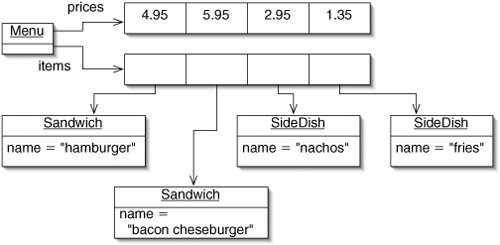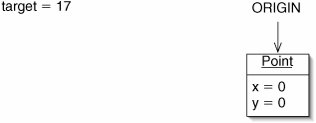B.2. Instance Diagrams
A UML instance diagram, also known as a UML object diagram, shows a snapshot of the state of one or more objects. These diagrams are used extensively in Part I of this book, and are crucial to understanding the linked structures introduced in Chapter 6.
More than one instance of a class may be shown in an instance diagram (Figure B-8). Static fields and all methods are omitted, as they are the same for every instance. The name of the class of each instance is underlined, but not bold. A specific value is given for each primitive field.
Figure B-8. UML instance diagram showing two instances of the Starship class.

References are shown as arrows. In Figure B-9, the instance of class Outfit has four fields: price, top, bottom, and feet. Technically speaking, fields of type String are references to instances of the String class, but we omit this detail for clarity.
Figure B-9. An instance of class Outfit with references to three other objects.

A number of minor extensions to standard UML instance diagrams are used in this book.
First, a null reference is sometimes shown as a line ending in a large dot (Figure B-10). If including such lines would complicate the diagram excessively, null references are simply omitted.
Figure B-10. In this instance of class Outfit, the feet field contains a null reference.

Second, arrays are shown as rows of boxes (Figure B-11). Each box may contain a primitive value or a reference to an object or array.
Figure B-11. This instance of Menu contains two arrays, prices and items.

Third, variables, arguments, and constants are sometimes included in UML instance diagrams (Figure B-12).
Figure B-12. The variable target has the value 17. The constant ORIGIN is a reference to an instance of Point.

We end this appendix by noting that some special notation is used in Chapter 16, which deals with references in great detail.
Part I: Object-Oriented Programming
Encapsulation
Polymorphism
Inheritance
- Inheritance
- Extending a Class
- The Object Class
- Packages and Access Levels
- Summary
- Vocabulary
- Problems
- Projects
Part II: Linear Structures
Stacks and Queues
- Stacks and Queues
- The Stack Interface
- The Call Stack
- Exceptions
- The Queue Interface
- Summary
- Vocabulary
- Problems
- Projects
Array-Based Structures
- Array-Based Structures
- Shrinking and Stretching Arrays
- Implementing Stacks and Queues
- The List Interface
- Iterators
- The Java Collections Framework: A First Look
- Summary
- Vocabulary
- Problems
- Projects
Linked Structures
- Linked Structures
- List Nodes
- Stacks and Queues
- The LinkedList Class
- The Java Collections Framework Revisited
- Summary
- Vocabulary
- Problems
- Projects
Part III: Algorithms
Analysis of Algorithms
- Analysis of Algorithms
- Timing
- Asymptotic Notation
- Counting Steps
- Best, Worst, and Average Case
- Amortized Analysis
- Summary
- Vocabulary
- Problems
- Projects
Searching and Sorting
- Searching and Sorting
- Linear Search
- Binary Search
- Insertion Sort
- The Comparable Interface
- Sorting Linked Lists
- Summary
- Vocabulary
- Problems
- Projects
Recursion
- Recursion
- Thinking Recursively
- Analyzing Recursive Algorithms
- Merge Sort
- Quicksort
- Avoiding Recursion
- Summary
- Vocabulary
- Problems
- Projects
Part IV: Trees and Sets
Trees
Sets
- Sets
- The Set Interface
- Ordered Lists
- Binary Search Trees
- Hash Tables
- The Java Collections Framework Again
- Summary
- Vocabulary
- Problems
- Projects
Part V: Advanced Topics
Advanced Linear Structures
- Advanced Linear Structures
- Bit Vectors
- Sparse Arrays
- Contiguous Representation of Multidimensional Arrays
- Advanced Searching and Sorting
- Summary
- Vocabulary
- Problems
- Projects
Strings
Advanced Trees
- Advanced Trees
- Heaps
- Disjoint Set Clusters
- Digital Search Trees
- Red-Black Trees
- Summary
- Vocabulary
- Problems
- Projects
Graphs
- Graphs
- Terminology
- Representation
- Graph Traversal
- Topological Sorting
- Shortest Paths
- Minimum Spanning Trees
- Summary
- Vocabulary
- Problems
- Projects
Memory Management
Out to the Disk
- Out to the Disk
- Interacting with Files
- Compression
- External Sorting
- B-Trees
- Summary
- Vocabulary
- Problems
- Projects
Part VI: Appendices
A. Review of Java
- A. Review of Java
- A.1. The First Program
- A.2. Variables and Types
- A.3. Loops
- A.4. Interacting with the User
- A.5. Branching
- A.6. Methods and Breaking Out
- A.7. Constants
- A.8. Operators
- A.9. Debugging
- A.10. Coding Conventions
B. Unified Modeling Language
- B. Unified Modeling Language
- B.1. Class Diagrams
- B.2. Instance Diagrams
C. Summation Formulae
- C. Summation Formulae
- C.1. Sum Notation
- C.2. Sum of Constants
- C.3. Sum of First n Integers
- C.4. Sums of Halves and Doubles
- C.5. Upper Limit on Sum of a Function
- C.6. Constant Factors
D. Further Reading
Index
EAN: 2147483647
Pages: 216
